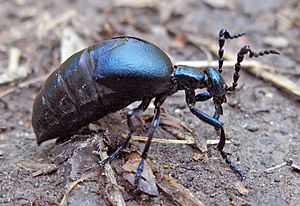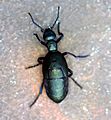Oil beetle facts for kids
The oil beetle is a fascinating type of beetle. They are known for a special way they defend themselves. When they feel threatened, they can release tiny drops of an oily, yellowish liquid. This liquid is actually their hemolymph, which is like their body fluid or "blood." This is why they are called "oil beetles"!
This special liquid helps protect them from predators. It contains a chemical that can irritate the skin and cause a small rash or swelling if it touches you. It's their way of saying, "Stay away!"
Oil beetles are quite unique because they do not have wings for flying. Their hard wing covers, called elytra, are much shorter than those of most other beetles. This means they can't fly, but they are still very good at walking and moving around on the ground.
Contents
What are Oil Beetles?
Oil beetles belong to a group of insects called blister beetles. There are many different kinds of oil beetles, and they can be found in various parts of the world. They often have a dark, shiny body that can look blue, purple, or black. Their bodies are usually quite soft compared to other beetles.
Where Do They Live?
You can often find oil beetles in grassy areas, meadows, and gardens. They prefer places where there are plenty of flowers and plants. This is because adult oil beetles like to eat pollen and nectar from flowers. They are important for helping to pollinate plants as they move from flower to flower.
Oil Beetle Life Cycle
The life cycle of an oil beetle is very interesting and a bit unusual for a beetle. It involves several different stages and even uses other insects!
Eggs and Larvae
Female oil beetles lay many eggs in the soil. When the eggs hatch, tiny larvae emerge. These larvae are called triungulins. They are very small and active.
Finding a Host
The triungulins do not stay on the ground for long. Their goal is to find a bee, usually a solitary bee. They climb onto flowers and wait for a bee to visit. When a bee lands on the flower, the triungulin quickly latches onto the bee's body.
Developing in the Bee's Nest
The triungulin then hitches a ride back to the bee's nest. Once inside the nest, the larva feeds on the bee's eggs and stored pollen and nectar. As it grows, it changes form several times, going through different larval stages.
Pupa and Adult
After feeding and growing, the larva changes into a pupa. This is a resting stage, similar to a butterfly's chrysalis. Finally, the pupa transforms into an adult oil beetle, which then emerges from the bee's nest to start the cycle all over again.
Defense Mechanism
The oily liquid that oil beetles release is a powerful defense. It contains a chemical called cantharidin. This chemical is what causes the skin irritation and blistering. It's a very effective way for the beetle to protect itself from predators like birds, lizards, and small mammals. They usually only release this liquid if they feel truly threatened, so it's best to observe them without touching them.
Images for kids
See also
 In Spanish: Carralejas para niños
In Spanish: Carralejas para niños



